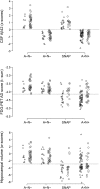Mild cognitive impairment with suspected nonamyloid pathology (SNAP): Prediction of progression
- PMID: 25568301
- PMCID: PMC4336071
- DOI: 10.1212/WNL.0000000000001209
Mild cognitive impairment with suspected nonamyloid pathology (SNAP): Prediction of progression
Abstract
Objectives: The aim of this study was to investigate predictors of progressive cognitive deterioration in patients with suspected non-Alzheimer disease pathology (SNAP) and mild cognitive impairment (MCI).
Methods: We measured markers of amyloid pathology (CSF β-amyloid 42) and neurodegeneration (hippocampal volume on MRI and cortical metabolism on [(18)F]-fluorodeoxyglucose-PET) in 201 patients with MCI clinically followed for up to 6 years to detect progressive cognitive deterioration. We categorized patients with MCI as A+/A- and N+/N- based on presence/absence of amyloid pathology and neurodegeneration. SNAPs were A-N+ cases.
Results: The proportion of progressors was 11% (8/41), 34% (14/41), 56% (19/34), and 71% (60/85) in A-N-, A+N-, SNAP, and A+N+, respectively; the proportion of APOE ε4 carriers was 29%, 70%, 31%, and 71%, respectively, with the SNAP group featuring a significantly different proportion than both A+N- and A+N+ groups (p ≤ 0.005). Hypometabolism in SNAP patients was comparable to A+N+ patients (p = 0.154), while hippocampal atrophy was more severe in SNAP patients (p = 0.002). Compared with A-N-, SNAP and A+N+ patients had significant risk of progressive cognitive deterioration (hazard ratio = 2.7 and 3.8, p = 0.016 and p < 0.001), while A+N- patients did not (hazard ratio = 1.13, p = 0.771). In A+N- and A+N+ groups, none of the biomarkers predicted time to progression. In the SNAP group, lower time to progression was correlated with greater hypometabolism (r = 0.42, p = 0.073).
Conclusions: Our findings support the notion that patients with SNAP MCI feature a specific risk progression profile.
© 2015 American Academy of Neurology.
Figures



References
-
- Ingelsson M, Fukumoto H, Newell KL, et al. Early Abeta accumulation and progressive synaptic loss, gliosis, and tangle formation in AD brain. Neurology 2004;62:925–931. - PubMed
